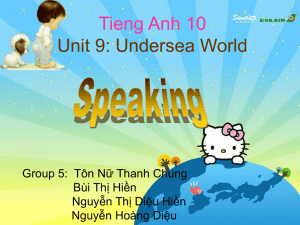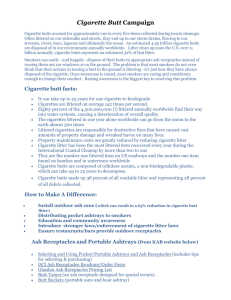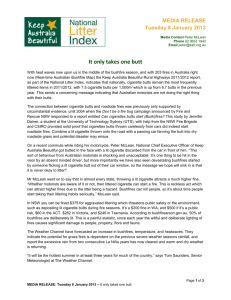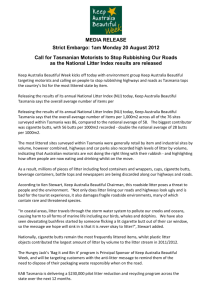Nicholas Schippers Environment 491 Senior Capstone Project
advertisement
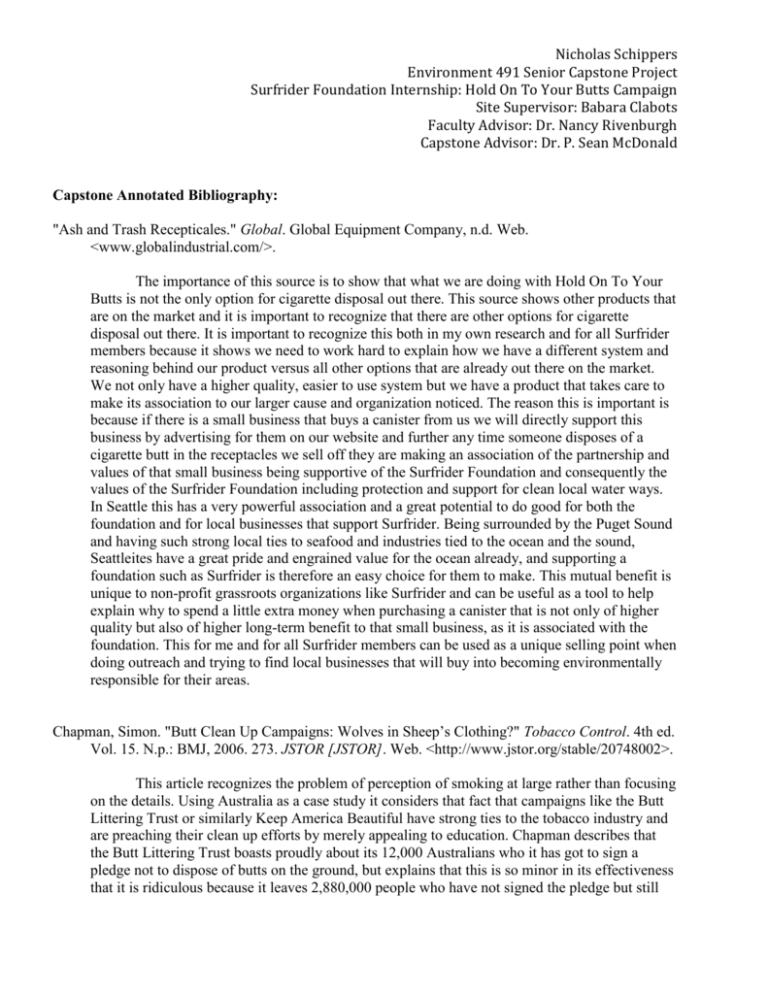
Nicholas Schippers Environment 491 Senior Capstone Project Surfrider Foundation Internship: Hold On To Your Butts Campaign Site Supervisor: Babara Clabots Faculty Advisor: Dr. Nancy Rivenburgh Capstone Advisor: Dr. P. Sean McDonald Capstone Annotated Bibliography: "Ash and Trash Recepticales." Global. Global Equipment Company, n.d. Web. <www.globalindustrial.com/>. The importance of this source is to show that what we are doing with Hold On To Your Butts is not the only option for cigarette disposal out there. This source shows other products that are on the market and it is important to recognize that there are other options for cigarette disposal out there. It is important to recognize this both in my own research and for all Surfrider members because it shows we need to work hard to explain how we have a different system and reasoning behind our product versus all other options that are already out there on the market. We not only have a higher quality, easier to use system but we have a product that takes care to make its association to our larger cause and organization noticed. The reason this is important is because if there is a small business that buys a canister from us we will directly support this business by advertising for them on our website and further any time someone disposes of a cigarette butt in the receptacles we sell off they are making an association of the partnership and values of that small business being supportive of the Surfrider Foundation and consequently the values of the Surfrider Foundation including protection and support for clean local water ways. In Seattle this has a very powerful association and a great potential to do good for both the foundation and for local businesses that support Surfrider. Being surrounded by the Puget Sound and having such strong local ties to seafood and industries tied to the ocean and the sound, Seattleites have a great pride and engrained value for the ocean already, and supporting a foundation such as Surfrider is therefore an easy choice for them to make. This mutual benefit is unique to non-profit grassroots organizations like Surfrider and can be useful as a tool to help explain why to spend a little extra money when purchasing a canister that is not only of higher quality but also of higher long-term benefit to that small business, as it is associated with the foundation. This for me and for all Surfrider members can be used as a unique selling point when doing outreach and trying to find local businesses that will buy into becoming environmentally responsible for their areas. Chapman, Simon. "Butt Clean Up Campaigns: Wolves in Sheep’s Clothing?" Tobacco Control. 4th ed. Vol. 15. N.p.: BMJ, 2006. 273. JSTOR [JSTOR]. Web. <http://www.jstor.org/stable/20748002>. This article recognizes the problem of perception of smoking at large rather than focusing on the details. Using Australia as a case study it considers that fact that campaigns like the Butt Littering Trust or similarly Keep America Beautiful have strong ties to the tobacco industry and are preaching their clean up efforts by merely appealing to education. Chapman describes that the Butt Littering Trust boasts proudly about its 12,000 Australians who it has got to sign a pledge not to dispose of butts on the ground, but explains that this is so minor in its effectiveness that it is ridiculous because it leaves 2,880,000 people who have not signed the pledge but still Nicholas Schippers Environment 491 Senior Capstone Project Surfrider Foundation Internship: Hold On To Your Butts Campaign Site Supervisor: Babara Clabots Faculty Advisor: Dr. Nancy Rivenburgh Capstone Advisor: Dr. P. Sean McDonald smoke. British American Tobacco has a major role in the campaign and is said to focus exclusively on education of smokers. Chapman expresses that any organization not tied to a tobacco company is focused on three main components, “reducing use, recycling and education” here he expresses how tobacco companies like British American Tobacco use campaigns like the Butt Littering Trust to falsely advertise that they are making significant impacts into addressing the issue of cigarette litter. This information is useful to the Surfrider foundation and myself in that it promotes my knowledge and can help improve other members’ knowledge of what is going on at a large scale to influence smoker’s behavior and perception of littering butts. It helps us look at the root of the issue to focus on the things that really make a difference. For example the smoking ban that just passed in Seattle city parks. This is the kind of action that Chapman would say makes a real difference, giving smokers less places to smoke translates directly to the number of cigarettes smoked and the number of smokers in an area and significantly impacts the number of cigarette butts littered each year. Chapman goes further to allocate only a small “Band-Aid” sized contribution from law enforcement and anti-littering provisions to the amount of cigarette butt litter produced by smokers. Overall I would say this information is useful because it lets us know more about how to address smokers’ behaviors and where their influence for these behaviors comes from. It also gives us valuable knowledge about where perceptions may be formed for both smokers and non-smokers may begin. If perception is influenced by highly publicized campaigns like Butt Littering Trust or Keep America Beautiful, which are sponsored and funded by the Tobacco Companies themselves then the messages and perceptions they are forming are based on false claims of success and effectiveness. Knowing this can help us to make more informed choices when looking at how to approach and communicate with both smokers and non-smokers on the issues of cigarette litter. Cox, J. Robert. "Chapter 8 Advocacy Campaigns and Message Construction." Environmental Communication and the Public Sphere. 3rd ed. Thousand Oaks, CA: Sage Publications, 2010. 209-39. Print. This whole book has quality information in it about changing managing and messaging issues related to the environment. In chapter 8 specifically they cover the points of how grassroots environmental organizations have been successful in getting their messages across and really making a change. They used the Zuni Salt Lake and Coal Mine campaign as an example and discuss the 4 major features of environmental campaigns that are successful including 1. “A campaign is purposeful, 2. A campaign is aimed at a large audience, 3. A campaign has a more or less specifically defined time limit, and 4. A campaign involves an organized set of communication activities.” This is very helpful to both myself and Surfrider in that it opens up some very key points about being successful as a non-profit looking for public support, it analyses specific case studies and pulls out the significant decisions made by each campaign that led to their success or lack there of. I can use this personally to help me identify key points to attack when doing outreach for the HOTYB campaign, and further Surfrider can use this in their Nicholas Schippers Environment 491 Senior Capstone Project Surfrider Foundation Internship: Hold On To Your Butts Campaign Site Supervisor: Babara Clabots Faculty Advisor: Dr. Nancy Rivenburgh Capstone Advisor: Dr. P. Sean McDonald mission and with their campaigns to make sure they are doing the right things to be successful in their actions. After all gaining public support is a huge part of being successful as a non-profit and is key in developing outreach systems that are ultimately impactful on policy. Changing policy is what it takes to get real reform within the government and these changes only come when there is large public support. This is becoming increasingly important as we move further into the anthropocene and look towards large-scale solutions to human interactions with the environment. Gersberg, Richard M., Kayo Wantanabe, John Rudolph, Chris Stransky, and Thomas E. Novotny. "Toxicity of Cigarette Butts, and Their Chemical Components, to Marine and Freshwater Fish. "Tobacco Control. By Elli Slaughter. 1st ed. Vol. 20. N.p.: BMJ, 2011. 25-29. The Environmental Burden of Cigarette Butts. JSTOR [JSTOR]. Web. <http://www.jstor.org/stable/41320123>. Study to express the toxicity of cigarette butts on certain marine organisms. Tests were conducted to find the LC50 (lethal concentration of toxins emitted that kills 50% of the population) based on organism and the number of cigarette or cigarette butts (including type, brand, and smoked vs. non-smoked) involved per liter. This is relevant to my own research in that it is a peer-reviewed article that correlates the toxicity of cigarette chemicals to the potential harm done to marine organisms. With this information I can accurately represent the importance of why cigarette butts are harmful to marine environments and why it is important to keep them off beaches and dispose of them in proper receptacles. Looking at the goal of Hold On To Your Butts (HOTYB) the campaign that I am working on within Seattle Surfrider it is clear that this information is important for the sake of making sure that our campaign is backed by science that proves the value and importance of what we are doing. This is information I can use while tabling or while interacting with people talking my surveys. It will help to give me credentials for having a strong perspective on the issue and how to resolve it. Further it will allow me to articulate the importance of my findings better within my deliverables and will benefit Surfrider by giving them another source for them to back up their causes surrounding beach cleanups and in particular the importance of cleaning up cigarette butts. Harris, W. C., D. R. Cook, K. F. Bedford, and Y. Zuo. "Out of the Smokescreen: Does and AntiSmoking Advertisement Affect Young Women’s Perception of Smoking in Movies and Their Intention To Smoke?" Tobacco Control. By C. A. Edwards. 3rd ed. Vol. 13. N.p.: BMJ, 2004. 277-82. JSTOR [JSTOR]. Web. <http://www.jstor.org/stable/20208267>. Focusing on the role of using anti-smoking advertisements in cinema before movies this study looks at how placing anti-smoking ads before movies with smoking present in them can significantly affect how young women in particular perceive smoking. It was found that using Nicholas Schippers Environment 491 Senior Capstone Project Surfrider Foundation Internship: Hold On To Your Butts Campaign Site Supervisor: Babara Clabots Faculty Advisor: Dr. Nancy Rivenburgh Capstone Advisor: Dr. P. Sean McDonald anti smoking ads prior to movies with significant smoking in them substantially “immunized” young women from increasing their likelihood of wanting to smoke in the future. The reason this information is important to me and to Surfrider is because it shows that there is influence in advertising that can affect smoker’s behaviors and perceptions of whether or not smoking is okay. Littering of cigarette butts is directly tied to the number of smokers that exist and therefore less smokers means less litter. Overall working with the Hold On To Your Butts campaign this opens the possibility of addressing smokers through media advertising. Now in this day and age targeting something like a short ad before YouTube videos would be a great way to spread education. Since going to the cinema is not necessarily the most popular type of watching entertainment anymore, something like targeting YouTube or Vimeo videos which are now extremely popular could have significant affects in educating our youth. Being a non-profit this could be hard but if there are already companies out there stressing the message, getting our logo out as an organization that is backing the cause could be a possibility. For my own research this helps me to delineate what kinds of messages really work and when. Further it helps me to see how I might be able to apply this knowledge to help Surfrider in approaching the public that we do outreach to with a more educated background of what is affective and what may be influencing perceptions to begin with. "Keep America Beautiful - Prevent Cigarette Litter." Keep America Beautiful - Prevent Cigarette Litter. N.p., n.d. Web. 15 Sept. 2015. <http://preventcigarettelitter.org/>. Keep America Beautiful is one of the most widely known campaigns around smoking and for good reason. This campaign is in large part focused on keeping cigarette litter off of the streets and in waste bins which sounds great at first right? The problem here is that even though they cite sources like the ocean conservancy, claim to be dedicated to keeping things clean the campaign itself made little if any progress and is more of an advertisement than it is a reflection of actual value. On the web page for Keep America Beautiful you can see directly on the bottom that there is three major sponsors. The sponsors are Reynolds American, Santa Fe Natural Tobacco Company, and Philip Morris USA. These three companies are major tobacco companies that have funded and backed the Keep America Beautiful campaign because they want people to keep smoking. As found in many of my previous sources, there is a direct link between smoking litter and number of smokers, and this link goes both ways. Throughout the site you will find no adverse messaging about smoking itself. More litter deters the social stigma that goes with smoking and makes it so that less people find smoking attractive. Thus getting rid of litter, or at least for these major tobacco corporations, appealing to America that this is what they are trying to do is a method for them to retain more smoking customers and limit their losses in an industry that like oil is prehistoric and dying. The importance of Keep America Beautiful to both Surfrider and myself cannot be understated. It is a massive campaign that reaches millions of individuals and influences a large amount of people in their perceptions on cigarettes and cigarette litter. Its essentially the same idea as their being filters on cigarettes which give them Nicholas Schippers Environment 491 Senior Capstone Project Surfrider Foundation Internship: Hold On To Your Butts Campaign Site Supervisor: Babara Clabots Faculty Advisor: Dr. Nancy Rivenburgh Capstone Advisor: Dr. P. Sean McDonald the image and perception of being cleaner when actually all scientific evidence shows that the filters are essentially useless and if anything add more harmful carcinogens to the picture because they are constructed form plastic. We can use the information on the Keep America Beautiful campaign to be aware of how mismanaged messaging out in the public sphere can create perceptions for both smokers and non-smokers about what is actually being done to stop cigarette litter. Leatherman, Stephan P. "Non-Smoking Policies and Their Outcomes on US Beaches." Journal of Coastal Research. By Eduard Ariza. 1A ed. Vol. 28. N.p.: Coastal Education & Research Foundation, 2012. 143-47. JSTOR [JSTOR]. Web. <http://www.jstor.org/stable/41332059>. Here we learn that aesthetics and environmental concerns are not the only relevant concerns to smoking policies, tourism and health also play a key role in decisions around smoking policies on beaches. Beaches are some of the most important tourist attractions worldwide and have a major role in the litter that is distributed into our oceans. In Florida the Keep Sarasota Beautiful campaign found that efforts made in beach clean ups and surrounding the idea of changing or enforcing policy led to the most significant difference. Their outreach using pocket ashtrays was not effective, having no impact on cigarette litter. The reason this is important to my own research and to that of Surfrider is that things such as pocket ash cans have come up multiple times and we can use information like this to see how successful such campaigns were elsewhere. In our case it is important to recognize that these did not work with the Keep Sarasota Beautiful campaign, and use this information to make decisions for our own campaign that will be beneficial which will let us be more efficient in the way we do our outreach. In my research on the perception of litter we can use this to analyze the fact that pocket ash cans without enforcement and education are useless, as most people don’t consider cigarette butts as litter associated with pollution. Within this study “peer pressure” is considered one of the most important factors in driving public perception and response changes in litter. Using this knowledge we can shift how we work towards approaching Seattle public on the issue. McDaniel, Patricia A. "Covering Their Butts: Responses to the Cigarette Litter Problem." Tobacco Control. By Elizabeth A. Smith. 2nd ed. Vol. 20. N.p.: BMJ, 2011. 100-06. JSTOR [JSTOR]. Web. <http://www.jstor.org/stable/41320202>. Though visibly biased this article is very sound in its research and is backed by a multitude of sound research articles that back the authors perspective. Overall this article is a very accurate critique of the cooperate control of the tobacco industry and it looks at how big name companies sponsor programs like Keep America Beautiful (KAB) which they use to try and mitigate their negative impacts. Again pocket ash cans and canisters for disposal come up here as well as smoker education as KAB worked to try an address cigarette litter problems Nicholas Schippers Environment 491 Senior Capstone Project Surfrider Foundation Internship: Hold On To Your Butts Campaign Site Supervisor: Babara Clabots Faculty Advisor: Dr. Nancy Rivenburgh Capstone Advisor: Dr. P. Sean McDonald through these mediums unsuccessfully. It is noted that there is a direct link between public perception and the litter of cigarette butts. Those who were neutral on the issue of smoking became anti Tobacco Company when they were presented with the overwhelming issue of cigarette butt litter. I can use this information in my research on perception and to help me with my internship through Surfrider in that knowing that KAB efforts in the last 10 years have not made any significant impact on the amount of cigarette litter produced and that cigarette litter is one of the leading issues when considering public acceptance of smokers and tobacco company continuation. More litter found and exposed to the general public coincides with higher disturbance and disapproval of the tobacco companies and their environmental as well as societal costs. Working with Surfrider to expose just how prevalent the issue of cigarette litter is we can use this information to help change public opinion in favor of proper disposal that actually works. KAB claims to have made a significant change in the amount of cigarette litter found on public beaches and other public areas but their claim is not backed by any scientific studies and has no substantial evidence to support it. Within my research knowing this will help me to address public opinion on the issue especially if this public opinion is misguided or mislead, and working for Surfrider it will be easy to use hard physical evidence recovered in beach clean ups as well as scientific evidence found in this study to prove that cigarette litter is still a major issue threatening our health as well as the health of the surrounding environment. Novotny, Thomas E. "Whose Butt Is It? Tobacco Industry Research About Smokers and Cigarette Butt Waste." Tobacco Control. By Elizabeth A. Smith. 1st ed. Vol. 20. N.p.: BMJ, 2011. 2-9. The Environmental Burden of Cigarette Butts. JSTOR [JSTOR]. Web. <http://www.jstor.org/stable/41320119>. Based on the finding in this study the solution to solving the problem of cigarette litter cannot be resolved without collaboration of tobacco control agencies and environmental advocates or groups. If these two groups put together a cohesive report they might “compel the industry to take financial and practical responsibility for cigarette waste”. The study found in addition to many other interesting facts that only 20% of smokers noticed disposal bins but use of disposal bins when noticed and if easily accessible was relatively high at 72%. Perception of cigarette litter they found has many roots and this article looks at perception of litter primarily by smokers. In my research and for Surfrider this will help us because it explains how smokers are sensitive to attacks on their behavior, and how they respond better to more mellow mannered and non-attack driven statements. This will help us in our approach to outreach and education and using a slogan like Hold On To Your Butts is a good approach because it appeals to humor, which is something that deters negative connotations and reactions. According to research by the tobacco industry smokers themselves have negative views of cigarette litter if they know and consider it as litter, but major issues stem from lack of policy and enforcement as well as a social stigma that it is acceptable to “flick” cigarette butts. Further some smokers associate stomping out their butts as a good thing because they are reducing fire hazard. In British studies in Nicholas Schippers Environment 491 Senior Capstone Project Surfrider Foundation Internship: Hold On To Your Butts Campaign Site Supervisor: Babara Clabots Faculty Advisor: Dr. Nancy Rivenburgh Capstone Advisor: Dr. P. Sean McDonald particular there was over half the participants in one and over a quarter in another who attributed some of their habit of stomping out butts to prevent fires. Overall this article showed me that there are a lot of perspectives within smokers and non-smokers as to the social acceptability of flicking cigarette butts on the street. Everything from location, to social class, to type of cigarette plays a roll in how individuals perceive flicking butts. This will help all involved in education and outreach because it shows that there is a lot to consider when approaching smokers or nonsmokers in an attempt to raise awareness or provide education on the matter. Many who smoke do not even perceive dropping cigarette butts on the street as littering, and most are unaware that there are environmental consequences related to dropping them on the street. Overall many smokers know that the filters in cigarettes are plastic, but do not realize that this means they are litter or can be recycled. Oakes, Wendy, and Diane Bull. "Out of the Smokescreen II: Will an Advertisement Targeting the Tobacco Industry Affect Young People’s Perception of Smoking and Their Intentions to Smoke?" Tobacco Control. By Christine Edwards. 3rd ed. Vol. 16. N.p.: BMJ, 2007. 17781. JSTOR [JSTOR]. Web. <http://www.jstor.org/stable/20748152>. Looking further into the case of smoking within media and cinema, this study thinks about the appeals of smoking when tied to likeable characters or lead rolls in movies and looks at its affect on perceptions of youth on smoking. Tying smoking to individuals that are likeable and attractive is found to have a positive affect on youth leading towards a greater approval of smoking and a higher likelihood of youth smoking later in life. It was found that youth have particularly high influence from advertising compared to adults. In addition advertisements that appealed to adverse health affects did better at counteracting smoking in the cinema than advertisements attacking the smoking industry for perpetuating the issue. It is thought that making the connection from the smoking industry to adverse health and environmental affects requires greater knowledge and understanding than the youth that were surveyed had incurred yet. The reason this is helpful for me in understanding perception around smoking and consequently smoking litter is that visual aids around deteriorating health can result in higher response rates and reluctance to smoke when shown to youth. For Surfrider and myself and my research this means that given certain circumstances after building some rapport with individuals I could appeal to them via visual non-smoking aids whether they are smokers or not to help deter them from smoking and consequently littering in the future. Beyond this the study provides me with information that youth who have already seen anti-smoking ads have some sort of perception preformed about smoking that is alignment with these ads, and on the other side of this the same goes for those who have only seen pro smoking messaging even if subliminally and not in the form of advertising. Today there is less and less pro smoking advertising and the direct result is less smokers and less litter of cigarette butts. However still finding cigarette butts means there is still a massive misconstrued message around the litter of cigarettes. If we could appeal to the adverse health affects of not only smoking but also cigarette litter we might be able to change Nicholas Schippers Environment 491 Senior Capstone Project Surfrider Foundation Internship: Hold On To Your Butts Campaign Site Supervisor: Babara Clabots Faculty Advisor: Dr. Nancy Rivenburgh Capstone Advisor: Dr. P. Sean McDonald perceptions around the social norm that it is okay to litter cigarette butts. Using advertisement that shows the process of the direct health affects that could be tied not only to smoking but to littering of cigarette butts as well could have a large affect in how people and in particular youth see the affects of cigarette litter and the importance of campaigns like Hold On To Your Butts. Williams, A. T. "Public Perception and Opinion of Visible Beach Pollution: The Utilization of Photography." Journal of Coastal Research. By D. T. Tudor. 4th ed. Vol. 19. N.p.: Coastal Education & Research Foundation, 2003. 1104-115. JSTOR [JSTOR]. Web. <http://www.jstor.org/stable/4299252>. Within this paper it is found that using colored photography is as useful as using an actual item or surrogate item to survey public perception of beach litter. Tudor and Williams looked at 28 separate beach litter items and used photographs of the items to assess public perception of threat relative to each of the 28 items. They found that Items such as used syringes or pill bottles still containing prescription medicine ranked the highest along with items such as broken glass. Cigarette butts scored relatively low on perception of danger averaging 18th overall across the multiple beaches surveyed. This information is relevant to my research and to Surfrider because it shows that we can use pictures to get the same effect as using actual cigarette butts when surveying the public. However I would say that this does not account for the use of our massive 5 gallon water jug full of butts which I would associate as being significantly more effective for drawing concern from public beach goers. Considering the relatively low score of cigarette butts within this survey I would say that education of those we talk to is of the most importance to influence perception. Placing high emphasis on cigarette butts being plastic and explain how the toxins trapped in the filters make their way into our marine ecosystems polluting the fish we eat makes a full circle connection that can be effective in changing perception of the harm posed by the unassuming cigarette butts. It was found here that the least offensive litter items were those considered to be of natural construction. If people continue to believe that Cigarette butts are comprised of biodegradable material there is a serious misconception that will drive public opinion to consider them as not of great danger. In our outreach efforts emphasis on the real danger and construction of cigarette butts is crucial to the success of the HOTYB campaign. Notes: There is a unique commonality between all the sources I have chosen here. Each one specifically deals with a different idea but all ties back to both the marketing of the canisters that the Surfrider campaign Hold On To Your Butts is distributing and they tie back to my own research questions from my proposal. Many of the sources recognize other attempts at eliminating cigarette litter such as pocket ash cans and other canisters and show where they may have gone wrong or were not successful. The idea behind this bibliography is not only to provide Nicholas Schippers Environment 491 Senior Capstone Project Surfrider Foundation Internship: Hold On To Your Butts Campaign Site Supervisor: Babara Clabots Faculty Advisor: Dr. Nancy Rivenburgh Capstone Advisor: Dr. P. Sean McDonald my own studies with quality information but is to give Surfrider some resources that will help them to tailor programs like Hold On To Your Butts down the line to become more effective in their messaging and more responsive and productive in their attempts to gain public support. Overall the significance of these sources in combination shows that public perception of smoking and of cigarette litter is formed and tailored by many different viewpoints. Thus there is no set recipe to getting the public to buy into what we are doing. However the sources do give quality information as to what is and is not working in attracting public opinion and leads us to realize that there are some key components to address whenever working with and environmentally related issue like cigarette litter. For Surfrider this bibliography can be used to help support any claims made by members when discussing the importance of taking care of cigarette litter and further it can help to lead campaigns like Hold On To Your Butts to becoming more successful in their attempts to catch the attention of the public.
